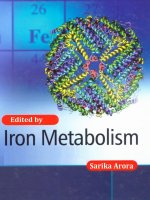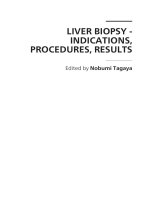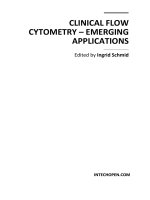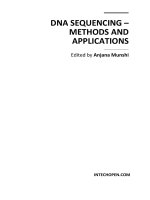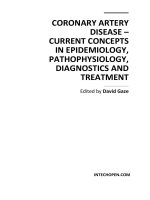Osteosarcoma Edited by Manish Agarwal ppt
Bạn đang xem bản rút gọn của tài liệu. Xem và tải ngay bản đầy đủ của tài liệu tại đây (12.25 MB, 182 trang )
OSTEOSARCOMA
Edited by Manish Agarwal
Osteosarcoma
Edited by Manish Agarwal
Published by InTech
Janeza Trdine 9, 51000 Rijeka, Croatia
Copyright © 2012 InTech
All chapters are Open Access distributed under the Creative Commons Attribution 3.0
license, which allows users to download, copy and build upon published articles even for
commercial purposes, as long as the author and publisher are properly credited, which
ensures maximum dissemination and a wider impact of our publications. After this work
has been published by InTech, authors have the right to republish it, in whole or part, in
any publication of which they are the author, and to make other personal use of the
work. Any republication, referencing or personal use of the work must explicitly identify
the original source.
As for readers, this license allows users to download, copy and build upon published
chapters even for commercial purposes, as long as the author and publisher are properly
credited, which ensures maximum dissemination and a wider impact of our publications.
Notice
Statements and opinions expressed in the chapters are these of the individual contributors
and not necessarily those of the editors or publisher. No responsibility is accepted for the
accuracy of information contained in the published chapters. The publisher assumes no
responsibility for any damage or injury to persons or property arising out of the use of any
materials, instructions, methods or ideas contained in the book.
Publishing Process Manager Ivana Zec
Technical Editor Teodora Smiljanic
Cover Designer InTech Design Team
First published April, 2012
Printed in Croatia
A free online edition of this book is available at www.intechopen.com
Additional hard copies can be obtained from
Osteosarcoma, Edited by Manish Agarwal
p. cm.
ISBN 978-953-51-0506-0
Contents
Preface VII
Part 1 Osteosarcoma Workup 1
Chapter 1 Histopathology and Molecular Pathology
of Bone and Extraskeletal Osteosarcomas 3
Helen Trihia and Christos Valavanis
Chapter 2 Imaging Osteosarcoma 41
Ali Nawaz Khan, Durr-e-Sabih,
Klaus L. Irion, Hamdan AL-Jahdali and
Koteyar Shyam Sunder Radha Krishna
Part 2 Osteosarcoma Treatment 83
Chapter 3 Misdiagnosis and Mistreatment for Osteosarcoma:
Analysis of Cause and Its Strategy 85
Yao Yang and Lin Feng
Chapter 4 Chemotherapy in Osteosarcoma 93
Kapadia Asha, Almel Sachin
and Shaikh Muzammil
Chapter 5 Limb Salvage for Osteosarcoma:
Current Status with a Review of Literature 109
Manish G. Agarwal and Prakash Nayak
Part 3 Osteosarcoma Research 137
Chapter 6 Bone Formation Deregulations Are
the Oncogenesis Keys in Osteosarcomas 139
Natacha Entz-Werlé
Chapter 7 The Retinoblastoma Protein in Osteosarcomagenesis 159
Elizabeth Kong and Philip W. Hinds
Preface
Osteosarcoma, is the most common malignant primary bone tumor. Though high
grade and potentially lethal, it is highly curable. Though a rare cancer, it
predominantly affects children and young adults and being highly curable, the
treatment strategy has permanent impact on the life of the patient. A plateau has been
reached in its outcome but a lot of research is now being aimed at molecular level to
find potential targets for treatment. The dissemination of knowledge coupled with
availability of affordable chemotherapeutic drugs and prosthesis have improved the
outcomes even in the developing world. The necessity of providing low cost treatment
has resulted in innovation in strategy and surgical approach.
Osteosarcoma is to orthopaedic oncology what tuberculosis is to infection. Both have
varied spectrum of presentation and can mimic a host of conditions. This book is not
meant to be a treatise on osteosarcoma. As the title suggests, it is a fresh look at this
disease with an aim to update the existing knowledge on etiology, pathology and
workup and to provide a look at the chemotherapeutic and surgical strategy.
Importance has also been given to the new research which could potentially change
the systemic treatment.
What is also different about this book is that it is online, open access and has been
done in a short turnaround time keeping the information very current at time of
publication. The authors have published in this field before and many have experience
of seeing hundreds of osteosarcomas. This book should be useful to clinicians,
researchers as well as students with an interest in the field of osteosarcoma.
Manish Agarwal
Hinduja Hospital, Mumbai,
India
Part 1
Osteosarcoma Workup
1
Histopathology and Molecular Pathology of
Bone and Extraskeletal Osteosarcomas
Helen Trihia and Christos Valavanis
“Metaxa” Cancer Hospital, Department of Pathology and Molecular Pathology Unit
Greece
1. Introduction
Osteosarcoma has been recognized for almost two centuries and is the most common
primary, non-haemopoietic malignant tumour of the skeletal system. It is thought to arise
from primitive mesenchymal bone-forming cells and its histologic hallmark is the
production of osteoid. Other cell populations may also be present, as these types of cells
may also arise from pluripotential mesenchymal cells, but any area of bone or osteoid
synthesized by malignant cells in the lesion establishes the diagnosis of osteosarcoma
(Acchiappati et al, 1965).
It accounts for approximately 20% of all primary malignant bone tumours. In the United
States, the incidence of osteosarcoma is 400 cases per year (4.8 per million population <20 y).
The incidence is slightly higher in blacks than in whites (Huvos et al, 1983), in males than in
females. It has a bimodal age distribution and a propensity to develop in adolescents and
young adults (Dix et al, 1983; Soloviev, 1969; Wilimas, et al, 1977, Dorfman & Czerniak,
1995), with 60% of tumours occurring in patients younger than 25 years of age and only 13%
to 30% in patients older than 40 years (de Santos et al, 1982; Huvos, 1986). Osteosarcoma is
very rare in young children (0.5 cases per million per year in children <5y).
Osteosarcoma can occur in any bone, but most tumours originate in the long bones of the
appendicular skeleton, near metaphyseal growth plates, especially the distal femur (42%, 75%
of which in the distal femur), followed by the proximal tibia (19%, 80% of which in the
proximal tibia) and proximal humerus (10%, 90% of which in the proximal humerus) (Goes M,
1952). In the long bones the tumour is most frequently centered in the metaphysis (90%),
infrequently in the diaphysis (9%) and rarely in the epiphysis (Tsuneyoshi & Dorfman, 1987).
Other significant locations are the skull and jaw (8%) and pelvis (8%) (Benson et al, 1984).
The clinicopathologic features of osteosarcoma form the basis of its classification, most
importantly including the histologic features, the biologic potential (grade), relation to bone
(intramedullary or surface), multiplicity (solitary and multifocal) and the pre-existing state
of underlying bone (primary or secondary).
Osteosarcomas have a wide range of radiographic and histologic appearances. For example,
some may be radiolucent or radiodense. Some are confined to the medullary cavity, or
originate and grow on the bone surface. Some arise on normal bone (de novo osteosarcoma),
others arise in the setting of Paget disease or radiation (secondary osteosarcoma). Most arise
Osteosarcoma
4
in genetically normal individuals but rare cases have been seen in patients’ various genetic
syndromes (such as Rothmund-Thompson, Li Fraumeni and Retinoblastoma gene mutation)
(Dick et al, 1982; Hansen et al, 1985; Kozlowski et al, 1980). The vast majority are solitary
lesions, although rare cases of multifocal osteosarcomas have been reported (Ackermann,
1948, Amstutz, 1969, Laurent et al, 1973).
According to the mode of growth, osteosarcomas are subdivided into intramedullary and
surface osteosarcomas. Intramedullary osteosarcomas are further subdivided into typical
intramedullary, telangiectatic and highly differentiated. Surface osteosarcomas are subdivided
into periosteal and parosteal osteosarcomas and high-grade surface osteosarcomas. According
to the prevalent cell in the neoplastic tissue are subdivided into osteoblastic, chondroblastic,
fibroblastic, giant cell, small cell and mixed (McDonald & Budd, 1943).
Most osteosarcomas can be categorized into four major groups: 1) conventional, high grade
osteosarcoma and its histologic subtypes (75%-85%), 2) high grade osteosarcoma that arises
in a diseased bone (10%), 3) intramedullary, well-differentiated (1%) and 4) surface
osteosarcoma (5%-10%).
Bone tumour grading has traditionally been based on a combination of histologic diagnosis
and the Broders grading system which assesses cellularity and degree of anaplasia (Broders,
1920; Inwards & Unni, 1995). The 7
th
edition of the AJCC Cancer Staging Manual
recommends a 4-grade system (Edge et al, 2009), with grades 1 and 2, considered as ‘low
grade’ and grades 3 and 4 ‘high grade’. The 2009 CAP Bone Tumour Protocol recommends a
pragmatic approach, based principally on histologic classification. Under this system,
central low grade osteosarcoma and parosteal osteosarcoma are considered Grade 1
sarcomas, with periosteal osteosarcoma considered Grade 2, and all other osteosarcomas
considered Grade 3 (Dorfman et al, 1998, 2002).
The exact cause of osteosarcoma is unknown. The best known causative association -
environmental risk factor is exposure to radiation (Huvos, 1986). Its causal relation was first
documented in radium dial painters. Osteosarcoma after therapeutic irradiation is an
uncommon complication, and usually develops after approximately 15 (range 3 to 55) years.
Osteosarcoma is known to affect approximately 1% of patients with Paget disease of bone,
which reflects a several thousand-fold increase in risk in comparison with that of the general
population (Wick et al, 1981).
Osteosarcoma may also arise in sites of previous bone infarction (Mirra et al, 1974), chronic
osteomyelitis (Bartkowski & Klenczynski, 1974; Spyra, 1976), pre-existing primary benign
bone tumours (osteochondroma, enchondroma, fibrous dysplasia, giant cell tumour,
osteoblastoma, aneurysmal bone cyst and unicameral bone cyst) and adjacent to metallic
implants (Johnson et al, 1962; Koppers et al, 1977, Ruggieri 1995; Schweitzer & Pirie, 1971;
Smith et al, 1986). These secondary osteosarcomas account for only a small percentage of
osteosarcomas and their pathogenesis is likely related to chronic cell turnover that is
associated to the underlying bone disease.
The diagnosis of osteosarcoma, like all bone-tumours, emphasizes the necessity of close
cooperation of all involved disciplines for diagnosis and therapy, including clinicians,
radiologists and pathologists, as the correct diagnosis relies on their clinico-pathological
appearance.
Histopathology and Molecular Pathology of Bone and Extraskeletal Osteosarcomas
5
2. Pathologic features
2.1 Conventional osteosarcoma
Conventional osteosarcoma, is solitary, arises in the medullary cavity of an otherwise
normal bone, is of high grade and produces neoplastic bone with or without cartilaginous or
fibroblastic components. The gross findings are variable depending on the amount of bone
and other components present. It manifests as a large, metaphyseal, intramedullary and tan-
gray-white, gritty mass. Tumours that are producing abundant mineralized bone are tan-
gray and hard, whereas non-mineralized, cartilaginous components are glistening, gray, and
may be mucinous if the matrix is myxoid, or more rubbery if hyaline in nature. It can be
necrotic, hemorrhagic and cystic. Intramedullary involvement is often considerable and the
tumour usually destroys the overlying cortex and forms an eccentric or circumferential soft
tissue component that displaces the periosteum peripherally. In the proximal and distal
portions of the tumour the raised periosteum deposits a reactive bone, known as Codman’s
triangle. In some cases, the tumour grows into the joint space, resulting in coating of the
peripheral portions of the articular cartilage by the sarcoma. Solitary or multiple skip
metastases appear as intramedullary nodules in the vicinity of or far from the main mass.
Furthermore, not all osteosarcomas arise in a solitary fashion, as multiple sites may become
apparent within a period of about 6 months (synchronous osteosarcoma), or multiple sites
may be noted over a period longer than 6 months (metachronous osteosarcoma). Such
multifocal osteosarcoma is decidedly rare, but when it occurs, it tends to be in patients,
younger than 10 years.
The diagnosis of osteosarcoma is based on the accurate identification of osteoid. Osteoid is
unmineralized bone matrix that histologically appears as eosinophilic, dense, homogeneous,
amorphous and curvilinear intercellular material, somewhat refractile. It must be
distinguished from other eosinophilic extra-cellular materials such as fibrin and amyloid.
Unequivocal discrimination between osteoid and non-osseous collagen may be difficult, or
sometimes arbitrary (Fornasier, 1977). Non-osseous collagen tends to be linear, fibrillar and
compresses between neoplastic cells. In contrast, osteoid is curvilinear with small nubs,
arborisation and what appears to be abortive, lacunae formation. The thickness of the
osteoid is highly variable with the ‘thinnest’ variant referred to as ‘filigree’, whereas osteoid
seams are flat and thick. Osseous matrix has also the predisposition for appositional
deposition upon previously existing normal bone trabeculae (‘scaffolding’).
Conventional osteosarcoma can produce varying amounts of cartilage and/or fibrous tissue.
The algorithm is: identify the presence or absence of matrix, and if significant matrix is
present, determine the matrix form and therefore subclassify into osteoblastic,
chondroblastic, fibroblastic and mixed types, by virtue of the predominance of the
neoplastic component.
Histologic subtyping may not always be possible, even with generous sampling. Such lesions
are better categorized under the term ‘osteogenic sarcoma with no predominant growth
pattern’. Furthermore, sub-classification on local recurrence or following chemotherapy or
irradiation can provide false results, because treatment can alter tumour appearance.
In addition, osteosarcoma may be of any histologic grade. Some contain highly pleomorphic
cells and abundant mitotic figures, whereas others may be difficult to differentiate from
benign neoplasms.
Osteosarcoma
6
2.1.1 Osteoblastic osteosarcoma
Conventional osteosarcoma is usually of the osteoblastic type. In osteoblastic osteosarcoma
the predominant matrix is bone and/or osteoid. It contains pleomorphic malignant cells and
coarse neoplastic woven bone. The tumour cells are intimately related to the surface of the
neoplastic bone, which is woven in architecture, varies in quantity and is deposited as
primitive, disorganized trabeculae in a coarse, lace-like pattern, thin, arborising lines of
osteoid (filigree) interweaving between neoplastic cells, or broad, large sheets of coalescing ,
trabeculae, as seen in the sclerosing variant. Depending on its state of mineralization, the
bone can be eosinophilic, or basophilic and may have a pagetoid appearance caused by
haphazardly deposited cement lines.
2.1.2 Chondroblastic osteosarcoma
Chondroid matrix is predominant in chondroblastic osteosarcoma, intimately associated
with non-chondroid elements. The neoplastic chondrocytes are mostly characterized by
severe cytologic atypia and reside in lacunar spaces, hyaline matrix or float singly or in
cords in myxoid matrix. Myxoid and other forms of cartilage are uncommon, except in the
jaws and in the pelvis.
2.1.3 Fibroblastic osteosarcoma
Typically, is composed of fusiform highly pleomorphic malignant cells, arranged in a
herringbone or storiform pattern, similar to fibrosarcoma or malignant fibrous histiocytoma,
with minimal osseous matrix. Although, the degree of atypia is variable, is frequently
severe, with numerous mitoses, including atypical forms. In general, the lack of significant
amounts of osteoid, bone or cartilage, relegates them to subtypes of fibroblastic
osteosarcoma.
Although, there is a tendency for metastases of osteosarcomas to mimic the primary,
exceptions are frequent and is a higher than expected incidence of fibroblastic differentiation
in metastases.
2.2 Small cell osteosarcoma
It comprises 1.5% of osteosarcomas, with slight predilection for females and is composed of
small cells with variable degree of osteoid production (Sim et al, 1979). According to the
predominant cell pattern, tumours are classified to round cell type or short spindle cell type.
Nuclei can be very small to medium sized, with scanty amount of cytoplasm, comparable to
those of Ewing sarcoma and to large cell lymphoma respectively. The chromatin
distribution can be fine or coarse and the mitoses range from 3 to 5/per high power field-
HPF. Lace-like osteoid production is always present, although particular care must be taken
to differentiate osteoid from fibrin deposits that may be seen among Ewing sarcoma cells.
2.3 Telangiectatic osteosarcoma
When first recognized, telangiectatic osteosarcoma was considered a distinct clinical and
pathologic entity (Gaylord, 1903). On the basis of subsequent findings, telangiectatic
osteosarcoma was considered a variant of osteosarcoma (Ewing, 1922, 1939).
Histopathology and Molecular Pathology of Bone and Extraskeletal Osteosarcomas
7
It is rare, less than 4% of all cases of osteosarcomas and more frequent in the second decade
of life. Although, most frequently affects long tubular bones, has also been noted to arise in
extraosseous soft tissues in the forearm, thigh and popliteal fossa (Mirra et al, 1993).
Radiographically, is characterized by typically purely lytic destructive process, without
matrix mineralization. Clinically, a pathological fracture is present in one fourth of the cases.
On gross examination, there is a dominant cystic architecture in the bone medulla. The
cystic space is filled incompletely with blood clot, described as ‘a bag of blood’.
Histologically, the tumour is characterized by dilated, blood-filled or empty spaces,
separated by thin septae, simulating aneurysmal bone cyst. The cystic spaces are lined by
benign osteoclast-like giant cells, without endothelial lining. The septae are cellular,
containing highly malignant, atypical mononuclear tumour cells with high mitotic activity,
including atypical mitoses. The amount of osteoid varies, but usually is fine, lace-like and of
minimal amount, although it tends to be more prominent in metastatic foci. Therefore, it is
imperative that the entire specimen is meticulously examined histologically.
Telangiectatic osteosarcomatous differentiation has been reported in parosteal
osteosarcoma (Wines et al,2000), in dedifferentiated chondrosarcoma arising in the
background of osteochondroma (Radhi & Loewy, 1999), in association with aneurysmal
bone cysts (Adler, 1980; Kyriakos & Hardy, 1991), in osteitis deformans, as well as in cases
of malignant phylloedes tumour of the breast (Gradt et al, 1998) and in ovarian sarcomas
(Hirakawa et al, 1998).
2.4 Low grade central (well differentiated intraosseous/intramedullary) osteosarcoma
It accounts for 1-2% of all osteosarcomas and is the medullary equivalent to parosteal
osteosarcoma (Kurt et al, 1990; Unni et al, 1977). There is a tendency for a slightly older age
and slightly longer symptomatology in comparison to the conventional osteosarcoma. It is
important to recognize this subtype, since the patient tends to do much better, than those
with conventional osteosarcoma. It is a low grade fibroblastic osteosarcoma and is
histologically identical to parosteal osteosarcoma.
Histologically, contains long, parallel trabeculae or round islands of woven bone intimately
associated with a mildly to moderately cellular population of cytologically bland neoplastic
spindle cells with variable amounts of osteoid production. Nuclear enlargement and
hyperchromasia are generally evident with occasional mitotic figures (1-2 mitoses per 10
high power fields-HPFs). When involving the medullary canal it may be confused with
fibrous dysplasia (FD). Radiologically, FD is homogeneous (‘ground glass’ appearance),
whereas the well differentiated osteosarcoma is less so, and may show trabeculations.
Furthermore, a permeative growth pattern into the pre-existing lamellar bone or fatty
marrow is diagnostic. Microscopically, the trabeculae of FD tend to be rather short and
curled, whereas those of well differentiated osteosarcoma are longer and may be arranged
in parallel arrays. Again, cytologic atypia should be sought and is diagnostic if found.
Conventional osteosarcomas often have better differentiated, innocuous ‘normalized’ areas.
These should not be underdiagnosed as low grade osteosarcoma, since biologically they
behave accordingly to their more aggressive foci.
Desmoplastic fibromas may infiltrate the bone and can be diagnostically challenging. In
these cases, osteoid production should be sought. Radiographic evidence of matrix
production is helpful in establishing the correct diagnosis.
Osteosarcoma
8
(A) (B)
(C) (D)
(E) (F)
Fig. 1. (A-D) Intramedullary (central) low grade osteosarcoma (H&E stain). A. Long
parallel neoplastic bony trabeculae associated with spindle cell stroma. B. Hypocellular
spindle cell collagenized stroma with osteoid production C. Scattered fusiform cells with
nuclear enlargement (high magnification). D. Area of chondroblastic differentiation. (E, F)
Osteosarcoma fibroblastic type (H&E stain). E. Neoplastic bony trabeculae surrounded by
spindle cell stroma exhibiting scattered cytologic atypia prominent at low magnification. F.
Prominent cytologic atypia (high magnification)
Histopathology and Molecular Pathology of Bone and Extraskeletal Osteosarcomas
9
(A) (B)
(C) (D)
(E) (F)
Fig. 2. (A, B) Telangiectatic osteosarcoma (H&E stain). (A) Blood-filled cystic spaces,
separated by septae with abundant osteoclastic-type giant cells. (B) Giant cell-rich area with
high cellular pleomorphism and patchy osteoid formation. (C-E) Extraskeletal osteosarcoma
of the breast. (C) Well circumscribed margins, peripheral spindle cell component and
chondroblastic area (on the right). (D) Highy pleomorphic tumor cells including mitoses. (E)
Osteoblastic osteosarcoma area with abundant mineralized osteoid. (F) Fine needle aspirate
from extraskeletal osteosarcoma of the breast (MGG stain). Cellular smear displaying
epithelioid cells with plasmacytoid appearance. (Inset) Enlarged pleomorphic cell with fine
cytoplasmic vacuolization, reminiscent of neoplastic chondroblast in association with red-
purple amorphous material (reproduced with permission from S. Karger A.G., Medical and
Scientific Publishers, first published by Trihia et al, Acta Cytologica, 2007;51:443-450)
Osteosarcoma
10
2.5 Secondary osteosarcomas
Secondary osteosarcomas are bone forming sarcomas occurring in bones that are affected by
preexisting abnormalities, the most common being Paget disease and radiation change.
2.5.1 Paget osteosarcoma
Incidence of sarcomatous change in Paget disease is estimated to 0.7-0.95%, with
osteosarcomas representing 50-60% of Paget sarcomas (Haibach et al, 1985; Huvos et al,
1983; Schajowicz et al, 1983). It is more common in men, with median age of 64 years and is
usually observed in patients with widespread Paget disease (70%). Most tumours arise in
the medulla. Histologically are high grade sarcomas, mostly osteoblastic or fibroblastic. A
great number of osteoclast-like giant cells may be found. Telangiectatic and small cell
osteosarcomas have been reported.
2.5.2 Post-radiation osteosarcoma
They constitute 3.4-5.5% of all osteosarcomas and 50-60% of radiation-induced sarcomas. It is
estimated that the risk of developing osteosarcoma in irradiated bone is 0.03-0.8% (Huvos et al,
1985; Mark et al, 1994). Children treated with high-dose radiotherapy and chemotherapy are at
the greater risk, and the prevalence of post-radiation osteosarcomas is increasing as children
survive treatment for their malignant tumour. It can develop in any irradiated bone, with most
common locations the pelvis and the shoulder. The modified criteria for postradiation cancer
initially promulgated in 1948 by Cahan and associates are as follows : (1) the patient received
irradiation, (2) the neoplasm occurred in the radiation field, (3) a latent period of years had
elapsed, (4) histologic or radiographic evidence for the pre-existent osseous lesion, a benign
tumour or non-bone forming malignancy (Cahan et al, 1948).
Histologically, high grade osteosarcomas predominate.
Many of the reported cases of osteosarcoma arising in fibrous dysplasia have also been
complicated by radiation therapy.
2.5.3 Osteosarcomas in other benign precursors
Other rare instances of secondary osteosarcomas have included cases arising in association
with bone infarcts, endoprostheses and already mentioned fibrous dysplasia. Infarct
associated sarcomas as well as malignant tumours at the site of prosthetic replacements
(Brien et al, 1990), or at the site of prior fixation, most commonly show the histological
pattern of malignant fibrous histiocytoma (MFH), with a minority being osteosarcomas.
2.6 Parosteal osteosarcoma
It is the most common type of osteosarcoma of the bone surface, although it accounts for
about 5% of all osteosarcomas, with a slight female predominance (Okada et al, 1995). It is a
low grade, slow growing neoplasm, with a predilection for the posterior aspect of the distal
femur, where presents as a hard lobulated mass attached to the underlying cortex with a
broad base. Histologically, it is a well differentiated fibro-osseous neoplasm, consisting of
well formed bony trabeculae embedded in a hypocellular fibrous stroma. The bony
Histopathology and Molecular Pathology of Bone and Extraskeletal Osteosarcomas
11
trabeculae can be arranged in parallel strands, simulating normal bone and may or may not
show osteoblastic rimming. The intertrabecular stroma is hypocellular with minimal atypia,
whereas it can be more cellular with moderate cytologic atypia in 20% of cases. About 50%
of the tumours will show cartilaginous differentiation, in the form of hypercellular nodules
of cartilage within the tumour substance or as a cup on the surface. When present, the
cartilage cup is mildly cellular with mild cytologic atypia and lacks the ‘columnar’
appearance seen in osteochondromas.
About 15% of the tumours will show high grade spindle cell sarcoma (dedifferentiation),
more often at the time of recurrence, in the form of osteosarcoma, fibrosarcoma or MFH
(Wold et al, 1984).
Its diagnosis can be very difficult and the differential diagnosis has included diverse
entities, such as: myositis ossificans, fracture callus, ossifying haematoma, osteochondroma,
extraosseous osteosarcoma, parosteal chondroma, desmoplastic fibroma and osteoma.
Therefore, parosteal osteosarcoma, like no other tumour, implies the necessity of close
cooperation of all involved disciplines for the correct diagnosis.
2.7 Periosteal osteosarcoma
It accounts for less than 2% of all osteosarcomas, more common than high grade surface
osteosarcoma, but about one third as common as parosteal osteosarcoma (Unni et al, 1976).
Unlike parosteal osteosarcoma, which extends from the cortex like a bony knob, periosteal
osteosarcoma tightly encases the bone, like a glove. Unlike other osteosarcomas, it tends to
involve the diaphysis. Radiologically, it is a circumferential surface mass, less radiodense
than parosteal osteosarcoma. Mineralization occurs as ring-shaped radiodensities or as
streaks of reactive bone radiating from the surface. Lesions can be best visualized by MRI
scan. A sub-periosteal lesion with a bright white signal is present, indicating its high
cartilage content. Histologically, it has the appearance of a moderately differentiated, grade
2/3 chondroblastic osteosarcoma. It consists almost entirely of lobules of cellular, atypical
cartilage, with bone formation in the centre of the lobules, separated by thin strands of
fibrous tissue. Careful scrutiny of the fibrous component, reveals seams of neoplastic
osteoid, usually at the outer surface of the neoplasm, which distinguishes it from surface
chondrosarcoma.
2.8 High grade surface osteosarcoma
A high grade, bone-forming malignant tumour, arising from the bone surface, which
comprises less than 1% of all osteosarcomas. Histologically, is similar to conventional
osteosarcoma. Regions of predominantly osteoblastic, chondroblastic, or fibroblastic
differentiation may predominate. However all tumours will show high cytologic atypia and
lace-like osteoid. The pattern of osteoid production and the high grade cytologic atypia help
to separate it from parosteal osteosarcoma. High grade surface osteosarcoma with
chondroblastic differentiation may be confused with periosteal osteosarcoma. The degree of
cytologic atypia is greater in high grade surface osteosarcoma and the tumours generally
show larger spindle cell areas. Finally, unlike dedifferentiated parosteal osteosarcomas, low
grade regions are not found in high grade surface osteosarcomas.
Osteosarcoma
12
Cortical destruction and invasion into the medullary canal in high-grade juxtacortical
(periosteal and high-grade surface) osteosarcomas, is often absent, but when present, is only
focal. If extensive, it becomes difficult, if not impossible to distinguish an intramedullary
tumour with an eccentric soft tissue component from a surface neoplasm with extensive
invasion of the medullary canal.
2.9 Extraskeletal osteosarcomas
Extraskeletal osteosarcomas (EOs) or soft tissue osteosarcomas (STOs) are rare sarcomas
arising in extraskeletal somatic soft tissue, in which the neoplastic cells produce osteoid
and/or bone matrix, therefore recapitulating the phenotype of osteoblasts. By definition, it is
a high grade mesenchymal neoplasm that produces osteoid, bone and chondroid material,
shows no evidence of epithelial component and is located in soft tissues, without attachment
to bone or periosteum, as determined by X-ray findings or inspection during the operative
procedure. It is significantly less frequent than its osseous counterpart. They account for
1.2% of soft tissue sarcomas and 4% of osteosarcomas (Bane et al, 1990; Sordillo et al, 1983).
They typically arise in the deep soft tissues of the proximal extremities, with most common
locations the deep soft tissues of the thigh and buttocks, followed in descending order by
the upper limb, retroperitoneum, trunk, head and neck (Chung & Enzinger, 1987; Lee et al,
1995; Lidang et al, 1998; Sordillo et al, 1983). Fewer than 10% are superficial, originating in
the dermis or subcutis. Cases of EOs arising in unusual sites have been reported, such as the
breast, larynx, thyroid gland, parotid, abdominal viscera, including esophagus, small
intestine, omentum majum, liver, heart, the urogenital system, including urinary bladder,
ureter the prostate and the penis, pleura, mediastinum, ectopic thymus, pulmonary artery,
pilonidal area and aorta (Baydar, et al, 2009; Burke & Virmani, 1991; Kemmer et al, 2008;
Loose et al, 1990; Micolonghi et al, 1984; Piscioli et al, 1985; Shui et al, 2011; Silver &
Tavassoli, 1998; Trowell & Arkell, 1976; Young & Rosenberg, 1987; Wegner et al, 2010;
Greenwood & Meschter, 1989). Fewer than 300 cases have been reported to date and their
aetiology is essentially unknown. Unlike osseous conventional osteosarcoma, it typically
occurs in older adults, with a peak incidence in the fifth and sixth decades of life, in contrast
with skeletal osteosarcomas that most commonly affect young adults (Sordillo et al, 1983).
Males are affected more frequently than females at a ratio of 1.9:1. Some cases have been
associated with a history of prior therapeutic irradiation at the site of the tumour (Logue &
Cairnduff, 1991) and trauma (Allan & Soule, 1971). In one case report of primary
osteosarcoma of the urinary bladder, prolonged treatment with immunosuppressive
medications, including cyclophosphamide for active systemic lupus erythematosus (SLE)
has been reported (Baydar et al, 2009). The diagnosis is generally delayed and prognosis is
poor, with most patients died within months of diagnosis and with a cause-specific survival
rate at 5 years less than 25%. Clinically and mammographically can mimic a benign tumour.
Like most of soft tissue sarcomas, tumours may appear grossly circumscribed, however they
are microscopically infiltrative. Imaging studies usually reveal compact
calcifications/variable mineralization within the mass. Primary extraosseous osteosarcoma
should always be included in the differential diagnosis, in the view of a well demarcated
calcified mass on image analysis. In the case of extraskeletal osteosarcoma of the breast, an
underdiagnosis as a calcified fibroadenoma, should be avoided.
STOs are usually large, ranging in size between 5 and 10 cm, well-circumscribed, grossly
heterogeneous tumours that exhibit areas of haemorrhage and/or necrosis. Microscopically,
Histopathology and Molecular Pathology of Bone and Extraskeletal Osteosarcomas
13
STOs constitute highly cellular, cytologically pleomorphic, mitotically active sarcomas, spindle
cell to epithelioid in appearance. The defining feature is the presence of neoplastic osteoid
and/or bone. The latter usually presents in a ‘lace like’ manner, although solid sheets of
amorphous osteoid can also be found. When the bone/osteoid matrix is found only focally in
the tumour, largely demonstrates a nonspecific, undifferentiated, spindle cell sarcomatous
appearance. Lobules of highly cellular, atypical hyaline/fibrocartilage may also present.
Osteoclast-like giant cells have also been described. Various histologic subtypes of bone
osteosarcoma can be seen in extraskeletal osteosarcoma. Osteoblastic variant is the most
common type, followed by fibroblastic, chondroid, telangiectatic, small cell and well-
differentiated variants. Common to all variants is the production of osteoid, intimately
associated with tumour cells, which may be deposited in a lacy, trabecular or sheet-like
pattern. Neoplastic bone formation is more prominent in the centre of the tumour with the
peripheral areas being more cellular, a reverse pattern of myositis ossificans. In essence, any of
the microscopic patterns of high-grade intraosseous osteosarcoma may be seen in EO.
The differential diagnosis should always include spindle cell (sarcomatoid) carcinomas and
the exclusion of metastasis from a primary osteosarcoma, as well as carcinosarcomas,
malignant tumours with osseous metaplasia and sarcomas. Metaplastic ossification, ranging
from osteoid to woven bone formation can be seen in synovial sarcoma, epithelioid sarcoma,
liposarcoma and carcinosarcoma. Osteogenic differentiation can also be seen as a phenomenon
of dedifferentiation in various soft tissue sarcomas. In the above tumours, other histologic
lineages or histologic characteristics of original tumours are usually present. The key to
diagnosis, is the identification of the matrix surrounding the tumour cells and lack of epithelial
differentiation. Furthermore, except osteoblastic, chondroblastic and fibroblastic
differentiation, no other lineages of histologic differentiation should be detectable in EOs.
Diagnostic confirmation using immunohistochemical markers is necessary to ensure the
absence of an epithelial component and exclude the neoplasms of biphasic origin.
Immunohistochemical studies indicate that the EOs’ immunophenotype is similar to bone
osteosarcoma. EOs are uniformly positive for vimentin, they express smooth muscle actin
(68%), desmin (25%), S-100 protein (20%), including non-cartilaginous areas, EMA (52%),
Keratin (8%) and are negative for PLAP.
Differential diagnosis from recurrent or metastatic osteosarcoma is based on clinical history.
3. The use of cytology in the preoperative investigation of bone tumours with
emphasis in osteosarcoma
Fine needle aspiration (FNA) of bone lesions has been performed ever since the technique
was introduced (Coley et al, 1931). It has certain advantages over open biopsy, as it is less
disruptive to bone and permits multiple sampling without complications. Its main use is to
confirm malignancy. Although, cytomorphology of primary bone tumours has been
extensively described in correlation with histology (Hajdu, 1975; Stormby & Akerman,
1973Walaas &Kindblom, 1990; White et al, 1988), FNA is not as good for diagnosing primary
bone tumours.
There are two main indications of FNA of soft tissue and bone lesions: preoperative
diagnosis before definitive treatment and the investigation of lesions suspicious of tumour
recurrence or metastasis. Eventhough, the first use has limitations, however, at present, the
Osteosarcoma
14
use of FNA as the diagnostic, pre-treatment tool for musculoskeletal tumours is accepted in
many orthopaedic centres, provided that certain requirements are fulfilled and that the final
cytologic diagnosis is based on the combined evaluation of clinical data, radiographic
findings and cytomorphology (Domansky et al, 2010). One important reason, why FNA is
preferred upon open biopsy, is when the preoperative evaluation of a lesion as malignant is
of most importance, rather the subtype of the lesion. On the other hand, in the use of neo-
adjuvant treatment (radio- or chemotherapy), before surgery, the FNA diagnosis is of major
importance, analogous to histopathologic examination, in regard to subtype and tumour
grade. This is mostly the case with small round cell sarcomas. Regarding bone lesions, FNA
may also replace open biopsy in the primary diagnosis. It is the task of the pathologist to
distinguish benign and malignant primary bone tumours from metastatic deposits and from
the wide range of benign and inflammatory reactive lesions of the bone. Furthermore, the
pathologist should give a confident diagnosis of the various benign bone tumours and
sarcomas, if open biopsy is to be avoided. Skeletal aspiration is not different from other
aspirations, but it is important to remember that intact cortical bone cannot be penetrated by
regularly used (22 gauge) needles, something that can be easily done with partly destroyed or
eroded bone. A 18-gauge needle can be used in intact bone, under anaesthesia and multiple
passes can be performed. Many malignant bone tumours have palpable soft tissue
involvement, which can be much easier penetrated by the needle. In any case, it is strongly
recommended that the pathologist is familiar with the radiological findings, discuss the best
approach to the tumour with the radiologist and that non-palpable lesions are aspirated under
image-guided techniques. Essentially, when the aspirated material is technically satisfactory, it
is suitable for use of specialized techniques, likewise biopsy material, to assist in the diagnosis.
The FNA cytological findings of osteosarcoma have thoroughly been described (Mertens et
al, 1982; Walaas &Kindblom, 1990; White et al, 1988). They include mixture of cell clusters
and dispersed cells, pleomorphic, spindle and rounded cells with frequent mitoses,
including atypical forms, intercellular tumour matrix of osteoid, benign osteoclast-like giant
cells, epithelioid tumour cells, which may be of osteoblastic type, or resemble chondroblasts,
in osteoblastic and chondroblastic variants respectively, atypical spindle-shaped cells in
fibroblastic subtypes. The presence of osteoid-like material can be ‘prominent, or scarce,
dissociated, or in association with cell clusters, either as moderate-sized fragments, or not
easily discernible globule-like particles’. This material could be associated either with the
predominat histologic pattern or with the sampled area represented in the smears. Osteoid-
like matrix material has been originally described as ‘homogeneous or vacuolated
eosinophilic plaques’ or pink-purple acellular material in May Grunwald Giemsa (MGG)
smears and green-blue in Papanicolaou-stained (PAP) smears. Another cause of difficulty in
accurately assessing the presence of osteoid in the smears is that osteoid, cartilage and dense
collagen fibers appear very similar in both Diff-Quick and PAP stains. Furthermore, osteoid
resists the suction, during aspiration, and when aspirated, the small, disrupted fragments
lack the characteristic lattice-like pattern observed in histological sections (Mertens &
Langnickel, 1982; Nikol et al, 1998).
FNA has proven to be of value in the preoperative diagnosis of breast EOs (Trihia et al, 2007).
Its diagnosis is often delayed because of a desceptively benign clinical and radiologic
appearance (Watt et al, 1984). Although differential diagnosis from metaplastic carcinoma may
not be possible on cytological grounds alone, FNA has proven to be of value in preoperative
Histopathology and Molecular Pathology of Bone and Extraskeletal Osteosarcomas
15
diagnosis of malignancy and prompt surgical intervention, as clinically and mammographically
these lesions can be underdiagnosed as a benign tumour (Trihia et al, 2007).
4. The role of immunohistochemistry in the diagnosis of osteosarcoma
The diagnostic algorithm of primary bone tumors is, and always has been, a collaborative
effort in which clinical, radiologic, and pathologic findings have to be considered. In the
majority of cases, the pathologist can rely exclusively on histopathologic examination to
provide an accurate diagnosis. In some cases, however, ancillary studies have to be
employed to distinguish entities that share morphologic characteristics.
When evaluating a bone tumor, the pathologist is confronted with several difficulties. Bone
tumors are rare entities, and not all pathologists are exposed to bone pathology with the
frequency needed to gain the necessary level of diagnostic expertise. Also, certain osseous
tumors share histopathologic features and, in many cases, important diagnostic features
may not be readily evident in small specimens. Finally, intramedullary lesions often must be
decalcified, a process that may be associated with loss in cellular morphologic detail. All of
these factors complicate the diagnostic process. Diagnosis for many entities can be reached
by the evaluation of histopathologic features alone, or can be interpretated in the context of
clinico-radiologic findings, but for others, only a differential diagnosis can be reached
without ancillary studies.
Several studies have shown that gentle decalcification methods preserve antigenicity
relatively well for the most commonly used markers.
One of the greatest challenges in bone and soft tissue pathology is the reliable recognition of
osseous matrix production in malignant lesions. Although several antigens have been
explored, unfortunately, little is known about the antigenic specificity of normal bone tissue
and bone neoplasms and currently there is no specific marker to distinguish the bone matrix
from its collagenous mimics.
Since late 1990’s, due to their central function in the process of mineralization, a group of
proteins have been proposed for tumor diagnosis: alkaline phosphatase, osteonectin, and
osteocalcin. Osteocalcin (OCN) and osteonectin (ONN) have been applied to paraffin
sections and been used to highlight osteoid. OCN is one of the most prevalent intraosseous
proteins and is produced exclusively by bone-forming cells-osteoblasts and therefore has
received special attention as a specific marker (Fanburg et al, 1997, 1999; Takada et al, 1992).
In the detection of bone-forming tumors, osteocalcin has been associated with 70%
sensitivity and 100% specificity, compared with the 90% sensitivity and 54% specificity
reported for ONN. Nevertheless, OCN is rarely used in clinical practice. ONN is a protein
that is implicated in regulating the adhesion of osteoblasts and platelets to their extracellular
matrix, as well as early mineralization and should only be used as part of a panel of
reagents, directed at several lineage-related proteins (Serra et al, 1992; Wuisman et al, 1992).
Strong labeling of the osseous isozyme of alkaline phosphatase has been used to distinguish
EO from other pleomorphic sarcomas. The major drawback of this marker is that it can only
be used on cryostat sections and imprint smears.
Ancillary techniques have a limited role in diagnosing osteosarcoma, as the tumour is
largely recognized by its morphologic features. Because of the many varieties of
osteosarcoma, diverse tumours are considered in its differential diagnosis.
Osteosarcoma
16
Currently, immunohistochemistry has limited application in the differential diagnosis of
primary bone tumors. In general, osteosarcoma has a broad immunoprofile that lacks
diagnostic specificity. Vimentin, OCN, ONN, S-100 protein, muscle protein smooth muscle
actin (SMA), neuron specific enolase (NSE) and CD99 are some of the antigens that are
commonly expressed. Importantly, some tumours also stain with antibodies to keratin and
epithelial membrane antigen (EMA). Also, it’s worth noticing, that osteosarcoma usually
does not stain with antibodies to factor VIII and CD31.
Osteosarcoma is distinguished from benign tumours and fibro-osseous lesions, by virtue of
its infiltrative growth pattern, with the tumour replacing the marrow space and
surrounding bony trabeculae, which may also serve as scaffolding for the deposition of
neoplastic bone.
Telangiectatic osteosarcoma differs from aneurysmal bone cyst because it contains
cytologically malignant cells within the cyst walls, whereas the cells in aneurysmal bone
cyst are banal in appearance.
Biopsies of osteosarcoma that lack neoplastic bone can be problematic because its
immunophenotype can generate a broad list of differential diagnoses that include Ewing’s
sarcoma/Primitive Neuroectodermal Tumour-PNET, metastatic carcinoma and melanoma,
leiomyosarcoma and malignant peripheral nerve sheath tumour.
The subtype of osteosarcoma that most likely will benefit from the application of an
immunohistochemistry panel is the "small-cell" type. The diagnosis of this entity is difficult
due to the paucity of osteoid and the similarity to other small round-cell tumors. Although
the antigenic profile of small-cell osteosarcoma is unknown, expression of markers specific
for other small-cell tumors, help in ruling out this diagnosis.
In these circumstances, immunohistochemical analysis, electron microscopic evaluation and
molecular studies may be helpful. Small cell osteosarcoma is distinguished from Ewing’s
sarcoma by the presence of neoplastic bone and dilated rough endoplasmic reticulum by
electron microscopy, as osteosarcoma cells have the features of mesenchymal cells with
abundant endoplasmic reticulum and the matrix contains collagen fibres, which may show
calcium hydroapatite crystal deposition and the absence of t(11;22) translocation, or its
variants, which is diagnostic of Ewing’s sarcoma.
MIC-2 gene product (CD99), which is located in the short arm of the sex chromosome,
encodes a surface protein, first described in T-cell and null-cell acute lymphoblastic
leukemia. Osteosarcoma usually has a diffuse moderate to strong intracytoplasmic staining
for CD99. Tumour cells of the small cell variant of osteosarcoma may be positive for CD99,
vimentin, osteocalcin, osteonectin, smooth muscle actin, Leu-7 and KP1.
The differential diagnosis of osteosarcoma from other sarcomas (e.g., malignant fibrous
histiocytoma, fibrosarcoma) is important because of the specific therapy available for
osteosarcoma patients. Most osteosarcomas express vimentin and, according to some
authors, some tumors focally express cytokeratin and desmin, although these findings have
not been widely confirmed. Bone matrix proteins, such as OCN, alkaline phosphatase, and
ONN, are expressed in osteosarcomas. However, their presence has also been detected in
chondrosarcomas, Ewing’s sarcoma, fibrosarcomas, and malignant fibrous histiocytomas.
Caution should also be used in the interpretation of focal expression of a variety of markers
Histopathology and Molecular Pathology of Bone and Extraskeletal Osteosarcomas
17
(e.g., S-100, actin, epithelial membrane antigen) found occasionally in otherwise typical
osteosarcomas. Extraskeletal osteosarcomas of the fibroblastic subtype often have sparse
amounts of osteoid and can be differentiated from malignant fibrous histiocytoma on the
basis of strong expression of alkaline phosphatase. Chondroblastic osteosarcoma and
chondrosarcoma, however, cannot be distinguished immunohistochemically.
The different types of collagen present in the bone matrix are also produced by other tumors
and therefore have no application in differential diagnosis. The basic calponin gene, a
smooth muscle differentiation-specific gene that encodes an actin-binding protein involved
in the regulation of smooth muscle contractility, is expressed in osteosarcomas (Yamamura,
et al, 1998).
The list of entities included in the differential diagnosis of MFH is extensive.
Immunohistochemistry helps in the distinction of MFH (CD68+, OCN-, alkaline
phosphatase-) from leiomyosarcoma (CD68-), malignant neurilemmoma (S-100+) and from
fibroblastic osteosarcoma (occasionally positive for both OCN, alkaline phosphatase). The
distinction of cytokeratin-positive MFH from sarcomatoid carcinoma may be impossible by
immunohistochemistry and is best accomplished by electron microscopy.
Finally, stress fracture and accompanying callus can sometimes be confused with
osteosarcoma because the reactive bone and cartilage are deposited around pre-existing
bony trabeculae, mimicking an infiltrative pattern of growth. However, the cells in reactive
tissues are banal and osteoblastic rimming is usually present.
In conclusion, although immunohistochemistry does not currently play an important
diagnostic role in primary bone tumors as it does in soft-tissue counterparts, research efforts
to characterize the histogenesis of many of these neoplasias may offer new alternatives for
diagnosis in the near future. For the distinction of primary tumors versus metastases of non-
osseous origin and for the characterization of a small subset of neoplasias, such as those
with small round-cell morphology, immunohistochemistry remains the technique of choice.
5. Molecular pathology of osteosarcoma
Traditionally, our understanding of osteosarcoma has been largely based on anatomic and
histologic features. However, recent studies in the molecular pathology of osteosarcoma
have provided new insight into its pathogenesis. Through the identification of molecular
pathways of osteosarcoma development and progression, the roles played by mutated
tumor suppressor genes, oncogenes, and cell cycle regulatory molecules in bone
oncogenesis, differentiation, cell death and cell migration have been explored. Furthermore,
numerous cytogenetic abnormalities have been associated with osteosarcoma, including
chromosomal amplifications, deletions, rearrangements, and translocations.
Thus, the diagnostic and prognostic significance of molecular aberrations are beginning to
be evaluated and novel approaches for therapeutic interventions of osteosarcoma are being
developed.
5.1 Bone growth, differentiation and osteosarcoma tumorigenesis
It is well known that osteosarcoma has a propensity for developing in bone growth plates
characterized by rapid bone turnover during childhood and adolescence (Broadhead et al.,
2011; Gelberg et al., 1997)



